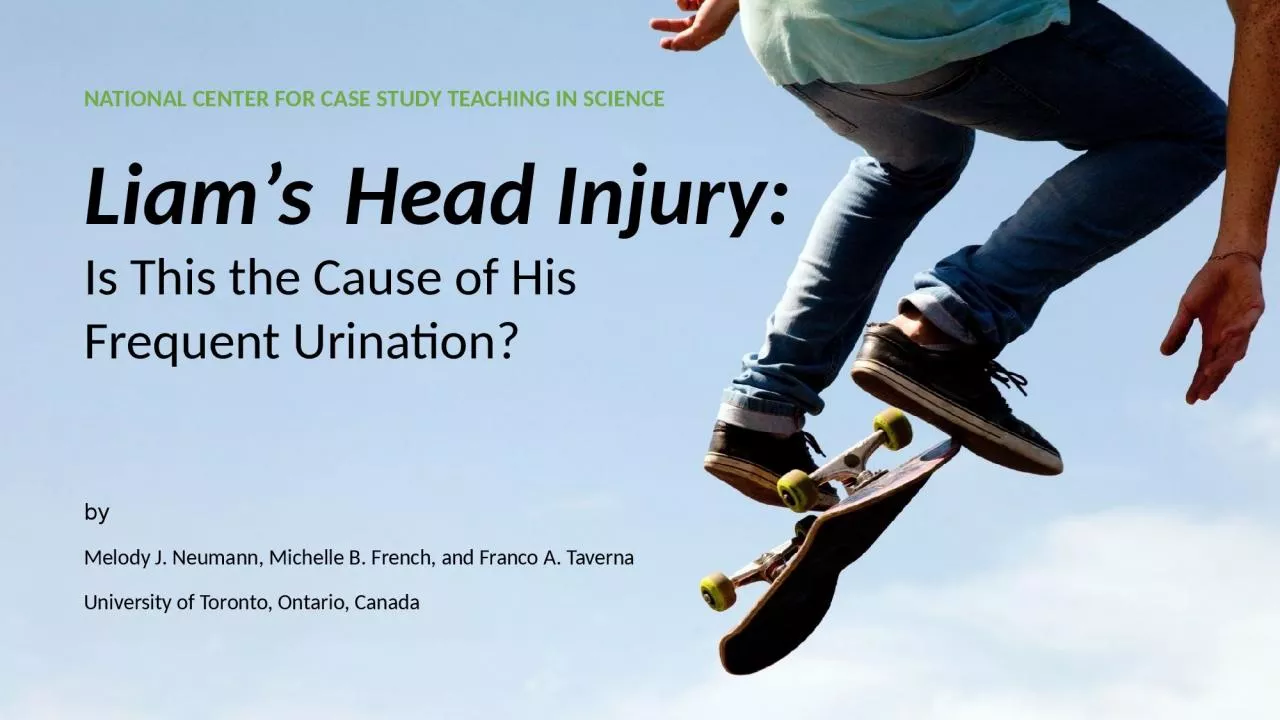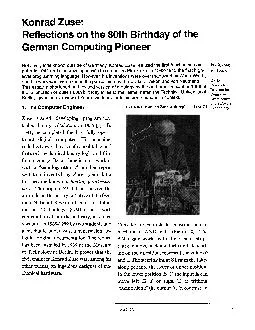PPT-by Melody J. Neumann, Michelle B. French, and Franco A. Taverna
Author : alyssa | Published Date : 2023-11-19
University of Toronto Ontario Canada Liams Head Injury Is This the Cause of His Frequent Urination NATIONAL CENTER FOR CASE STUDY TEACHING IN SCIENCE Meet Liam
Presentation Embed Code
Download Presentation
Download Presentation The PPT/PDF document "by Melody J. Neumann, Michelle B. French..." is the property of its rightful owner. Permission is granted to download and print the materials on this website for personal, non-commercial use only, and to display it on your personal computer provided you do not modify the materials and that you retain all copyright notices contained in the materials. By downloading content from our website, you accept the terms of this agreement.
by Melody J. Neumann, Michelle B. French, and Franco A. Taverna: Transcript
University of Toronto Ontario Canada Liams Head Injury Is This the Cause of His Frequent Urination NATIONAL CENTER FOR CASE STUDY TEACHING IN SCIENCE Meet Liam Liam has recently suffered a head injury when he fell while skateboarding Subsequently he has noticed that he is constantly thirsty that he needs to urinate more frequently and that his overall urine output is greater than before Is the head injury associated with his new symptoms Can he be treated . Melody Notes Melody Detection System MPD MPTC TrajectorySegment. NoteElimination MelodyExtraction OnsetDetection . Melody detection system overview. In the Multi-Pitch Detection (MPD) stage, the objec Core Principles. 1. Classes occur 80-90% in French; . 2. All variants of the French language, including the local variant in Maine, are celebrated with the children; . 3. The aim is to show the children that language and culture are inextricably linked and by valuing one we value the other. . Borel. and von Neumann Poker Models. Comparison . with . Real Poker. Real Poker:. Around . 2.6 million possible hands for 5 card stud. Hands somewhat independent for Texas Hold ‘. em. Let’s assume probability of hands comes from a uniform . User Interfaces. Workflow Repository . Third Party Tools. Web Portals / Gateways. Activity and Service Plug-in Manager. Workflow Provenance. Workflow Server. Secure Service . Access. Virtual Machine. and mythology. By: Melody Dias. Summary and Watercolor of the myth: . Syrinx. Nature Myth and Mask: How Song Came To Be. How Music Came to Be. (The story of Melody and Rhythm). In a forest on a day like no other, the air was cool and crisp. The sun peeked through the clouds and everything was perfect, for a little while. There in the forest sat a beautiful unique goddess. She had no idea what was about to start. Her name was Melody. Melody was a humble young girl who liked to have fun. On that day she said, “Everything’s so simple and boring. All I can do is soak my feet in the pond. Oh I do wish something, anything would happen.” . EDUARDO VILLANUEVA SÁIZ. 2014. LA ZONA MINERA BIZKAINA. ÍNDICE. DEFINICIÓN.. FUNCIONALIDAD.. LAS COMPAÑÍAS ORCONERA Y FRANCO-BELGA.. Cargadero de Orconera.. Cargadero de Franco-Belga.. BIBLIOGRAFÍA.. Strategic Context. The Seven Years’ War begins in Europe with a Prussian seizure of Saxony in 1756. Backed only by Britain, Frederick the Great’s Prussia finds itself surrounded and operating on interior lines against virtually all other European powers for survival, a coalition of France, Austria, Russia, Spain, Sweden, and Bavaria. In May 1757, Frederick invades the Austrian province of Bohemia and besieges Prague until an Austrian army forces him to withdraw after two desperate field battles at Prague and Kolin. The coalition plans subsequent invasions of Saxony, Brandenburg, East Prussia, and Silesia. Frederick, seeking an opportunity to defeat these armies in detail one at a time, marches west against the Franco-Austrian army invading Saxony. The combined Franco-Austrian army is suffering from desertion and a disunity between its two commanders.. Statistics. Record. . keeping. . at. . hospitals. . © 2008 Marietta Neumann / Children of Fire. 1. Aims. . of. . research. on . burn. . epidemiology. To. . determine. . most. . common. . Designing, Exchanging and Sharing of Scientific Workflows. Katy Wolstencroft. University of Manchester. Connecting things Together. Data Resources. Genome databases. Kinetic/metabolite data. Analysis tools. Presented by:. Lori Dehart. KEDC. Today’s Agenda. R. eview Terms & Concepts. . ` . SDI/SAS. Differentiated Instruction. UDL . Accommodations. Modifications. . . . . Today’s Agenda . Mr. Silvagni. Write a Bass Line. The last written section of the AP test asks you to write a bass line to a given melody. There are 8 measures in total and the bass line is provided for the first 2. 1/2. Learn French Language with Edubull French Language Course Online. Looking for French Lessons in French Language Classes, introduction to the French Language Basics with the French Language Learning App. Calabi-Yau Manifolds, Quivers and Graphs. Sebastián Franco. Durham University. Lecture 3. Sebastian Franco. <number>. Recent Developments 1: Cluster Integrable Systems. Sebastian Franco. Multiple Applications of Brane Tilings. the Z4 to the Technical University of Zurich (ETH), where it was in operation until 1953. A detailed description of the ar- chitecture of the Z1 and Z3 is provided in an article by Rafil Rojas 2. Afte
Download Document
Here is the link to download the presentation.
"by Melody J. Neumann, Michelle B. French, and Franco A. Taverna"The content belongs to its owner. You may download and print it for personal use, without modification, and keep all copyright notices. By downloading, you agree to these terms.
Related Documents














